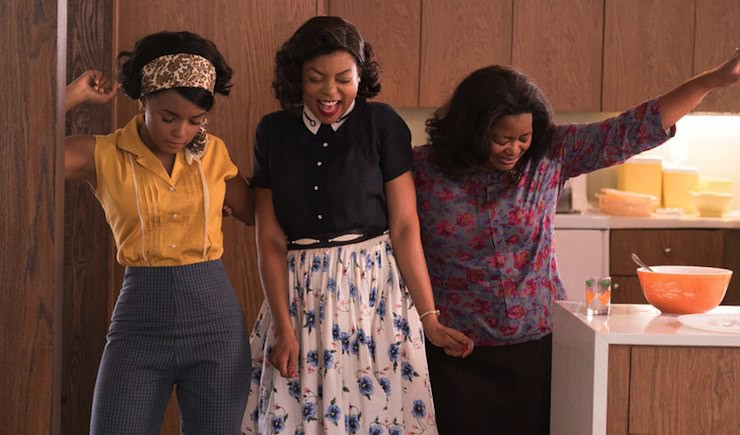Moogfest began as a one-day music festival celebrating both Robert Moog and electronic music in general. Over the last decade, it has grown into a multi-day symposium/festival with a scope that goes well beyond music and the circuit-driven gear that is used to make it. The daytime programming now includes discussions about transhumanism, cyborgs, race, and gender—and this year, the Afrofuturism programming track included a conversation with musician Janelle Monae and screenwriter Allison Schroeder, moderated by Kimberly Drew, who is Associate Online Community Producer at The Metropolitan Museum of Art.
Their conversation was billed as “Women and Afrofuturism”, but much of the discussion centered on the forthcoming film Hidden Figures, written by Schroeder and starring Monae, Taraji P. Henson, and Octavia Spencer. The film is a look at a little-known piece of space exploration history: the African-American women who worked for NASA during the Gemini and Apollo missions. In telling this story from the past, Schroeder, Monae, and the rest of the film’s team find a way forward; by revealing this untold story of women of color, they want to demonstrate the possibilities for others, whether in art, science, or both.
Hidden Figures is based on the forthcoming book by Margot Lee Shetterly. For the film, Schroeder has chosen to focus on three women—Mary Jackson, Katherine Johnson, and Dorothy Vaughan, in the period from 1958 to 1962. They were three of the so-called “colored computers”—a wince-inducing term to modern ears, but at the time the term “computers” was an actual NASA personnel classification. This cohort of black women mathematicians and engineers made the calculations that got John Glenn into orbit, Neil Armstrong to the moon, and Jim Lovell back to earth. Outside of NASA, it’s very hard to find information about these women, but Schroeder and Shetterly found that the agency itself is more than willing to share its archives, and to get the stories out.
Allison Schroeder has her own NASA ties—both her grandparents worked for the agency, her grandmother as an engineer, and Schroeder herself worked as an intern. In describing her enthusiasm for the story of Hidden Figures, she was passionate about how she wanted the heart of the story to be the friendship and mutual support amongst Jackson, Johnson, and Vaughan—”a love story to feminism”. For Schroeder, NASA is “a magical place”, bigger than any one individual. “If you could help, you were on the team,” she said, adding that one of her goals in the screenplay was to depict an organization where these women of color earned the respect of their peers and managers on the strength of their talents.
Janelle Monae is best known for her SF-inflected music, in particular the albums The Archandroid and Electric Lady. Hidden Figures is actually Monae’s second film—her first, Moonlight, will be released in September. In Hidden Figures, Monae plays Mary Jackson, the youngest of the core trio, and also the firebrand, who “says what women don’t get to say”. Jackson started working for NASA on the wind tunnel, and despite obstacles—an initially unsupportive husband, schools that would not admit her without a petition from the courts, skeptical professors—she became the first female engineer to work for NASA. Monae said that she saw a lot of herself in Jackson: in her fight for justice in her family and in the world, and in her refusal to be oppressed. It was important to her, Monae said, to “make sure I’m taking care of these voices that are being ignored”.
“I’m tired of our history getting overwritten,” Schroeder said, meaning the history of anyone who isn’t white and male. “We need to redefine what a hero looks like.” Monae agreed. “The world is changing fast,” she said, and a movie like this is key in representing women and people of color in music, film, art, and also STEM fields. She said that when she read the script, she found herself asking, “What else has been hidden from me?”—surprised that she, a woman and an SF fan, had never heard of these stories. Schroeder noted that two deaf women had developed the system that we use now to classify stars, another story of women in STEM that needs to be reclaimed. Dean also emphasized “the power of conceptualizing your own identity”—instead of saying that these women “defied the norm”, it’s more important to say that “they were their own norm”, implicitly rejecting the default white male narrative.
Schroeder, a self-described optimist, spoke about how she wanted her screenplay to portray not just the systems of oppression around Jackson, Johnson, and Vaughan, but also “people doing the right thing”, as a way of encouraging audiences to check their own actions. She acknowledged that some viewers might question why she, a white woman, had undertaken a story about women of color; what was important to her, she said, was telling stories outside of her own experience. Naturally, both Schroeder and Monae are hoping that the movie is a success—not only on behalf of the women portrayed in it, many of whom have passed on, unrecognized—but also as a message to contemporary audiences about diversity of narratives, role models, and possibilities for themselves. “We’re looking back,” Schroeder said, “but I hope we’re looking back in a new way.”
Karin Kross lives and writes in Austin, TX. She may be found elsewhere on Tumblr and Twitter.










